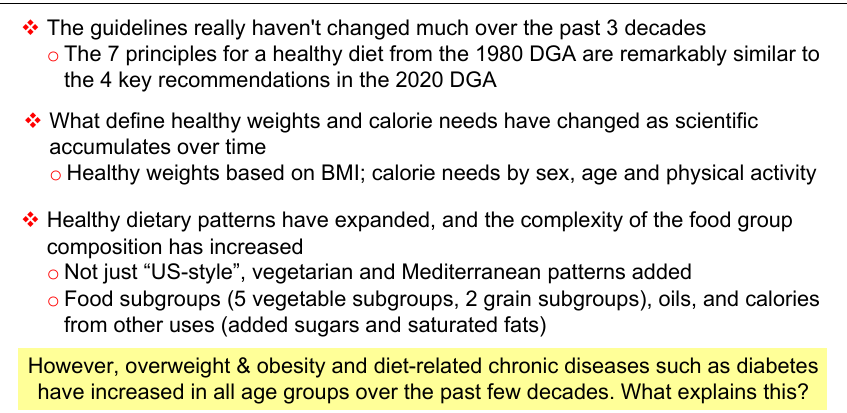Dietary Guidelines for Americans (DGA) Flashcards
1/35
Earn XP
Description and Tags
Flashcards based on lecture notes about the Dietary Guidelines for Americans (DGA).
Name | Mastery | Learn | Test | Matching | Spaced |
|---|
No study sessions yet.
36 Terms
What is the purpose of the Dietary Guidelines for Americans (DGA)?
To translate current science on diet and health into guidance on what and how much foods and beverages constitute healthy dietary patterns to meet nutrient needs, achieve good health, and reduce risk of diet-related chronic diseases.
What type of guidance does the DGA provide?
Quantitative guidance on foods and beverages, translating DRI recommendations into dietary recommendations.
What is the primary focus of the DGA?
Health promotion and disease prevention, not clinical guidelines for disease treatment.
How often is the DGA published, and by which agencies?
Every 5 years, jointly published by the HHS (Health and Human Services) and the USDA (United States Department of Agriculture).
Who uses the DGA?
Health and nutrition professionals, policymakers, state and local governments, schools, and the food industry.
What are the stages in the development of the DGA?
1) Identify topics and questions, 2) Examine the evidence (data analysis, systematic reviews, food pattern modeling), 3) Develop and write guidelines, 4) Implement DGA (e.g., using MyPlate).
What approaches are used to examine evidence in Stage 2 (appoint) of DGA Development?
Data analysis, Nutrition Evidence Systematic Review (NESR), and Food pattern modeling.
What were the key focus areas that evolved within the DGA from 1980-2020?
Key recommendations, healthy weights, calorie needs, healthy dietary patterns, and associated food group icons.
What was the precursor to the 1980 DGA?
The 1977 Dietary Goals.
What was a notable change in the 2015 DGA?
Dropping the recommendation to limit cholesterol intake to <300mg and adding a recommendation to limit added sugars to <10% of calories.
What significant change was introduced in the 2020 DGA regarding its applicability?
Expanding its use to all life stage groups, including infants.
List notable changes that occurred regarding the definition/description of 'healthy weights' throught the DGA revisions.
1980: Ideal Weight, 1985: Desirable Weight, 1990 Healthy Weight, 1995: First time BMI used, 2000: Term obese introduced
When was the first time that healthy weights were provided for children in the DGA? On what were they based?
2005, based on BMI-for-age percentile.
What does DASH stand for?
Dietary Approach to Stop Hypertension.
In what year did DGA documents add pictures to help people visualize what one cup-equivalent & one oz-equivalent look like?
2015
What are the four guidelines in the 2020 DGA? FCFL
- Follow a healthy dietary pattern at every life stage
- Customize and enjoy nutrient-dense food and beverage choices to reflect personal preferences, cultural traditions, and budgetary considerations
- Focus on meeting food group needs with nutrient-dense foods and beverages and stay within calorie limits
- Limit foods and beverages higher in added sugars, saturated fat, and sodium, and limit alcoholic beverages
In addition to guidelines #3 and #4, what are the 3 key dietary principles conveyed by the DGA committee to help people achieve a healthy dietary pattern?
- Ingest nutrients through food instead of relying on supplements
- Choose a variety of food
- Consider portion size
what nutrients are referred to as the nutrients of public health concern?
Calcium, potassium, dietary fiber, and vitamin D.
Which federal programs use DGA as the basis?
National School Lunch Program, Older Americans Act Nutrition Program, Special Supplemental Nutrition Program for Women, Infants & Children (WIC)
What are the 5 steps of establishing a DGA healthy dietary pattern? SNECC
Steps 1 & 2: Setting energy levels and nutrient goals. Steps 3-5: Establish food groupings, calculate nutrient profile for each food group/subgroup, choosing food groupings to meet nutrient goals
What does the Nutrition Care Process (NCP) include?
4 steps: nutrition assessment (ABCD), nutrition diagnosis, nutrition intervention, nutrition monitoring & evaluation
What are the 4 guidelines for 2020
Follow a healthy dietary pattern at every life stage. - Focus on variety, nutrient density, and amount. - Limit added sugars, saturated fat, and sodium. - Shift to healthier food and beverage choices.
how many calories levels are in the 2005 DGAs
12
take home messages for DGA 1980-2020

what are the vegetable subgroups
dark-dreen
red and orange
^ two above 40%
beans, peas, and lentils
starchy veggies
other
what are the two subgroups of grains
whole (half) and refined
what are the three subgroups of proteins
meat, poutry, and eggs. seafood (20%), and nuts
what is the percent of calories that we are reccomended to “other uses”
12%
define the PA levels and their corresponding numbers
sedentary: only the PA of independent living (1.0)
moderatey active: walking 1.5-3 miles per day at 3-4 miles per hour (1.12)
active: wwalking more than 3 miles per day at 3-4 miles per hourn(1.27)
what nutrient goals are not met and met at the best patterns
Vitamin D, E and choline are below for all.
Iron is below for women specifically
magnesium is below for men specifically
what score does the average american age 19-30
56
what food groups are below for the average american
veggies, fruits, and dairy, whole grains
what foods are way above average
added sugar, saturated fats, refined grains and sodium
what dietary components are of public health concern in America
calcium, potassium, diatery fiber, and vitamin D
what are the four nutrition assesments (ABCD)
Dietary, biochemical, clinical, and anthropometric assessments.
what are the four steps to the nutrition care process
Assessment, Diagnosis, Intervention, Monitoring and Evaluation.